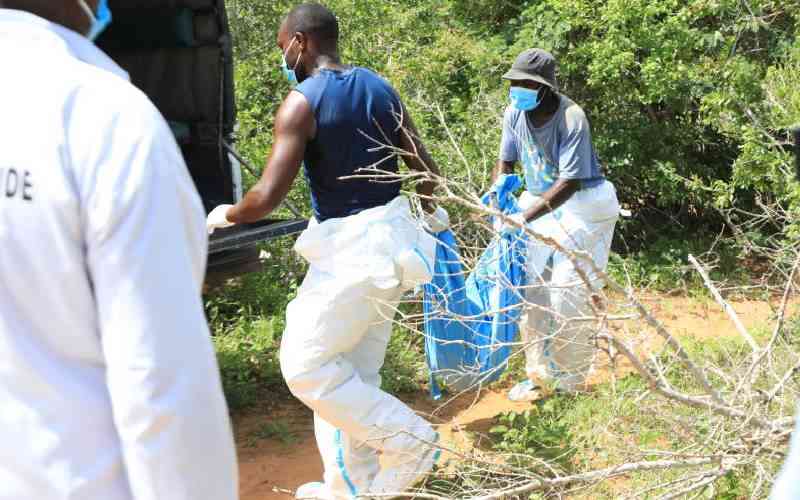By Pascal Mwandambo
Tsavo National Park, Kenya’s largest wildlife conservancy is on the throes of an ecological crisis.
Unless the Government comes up with management policies to save the 21,000 square kilometres game park, it is just a matter of time before the park goes the way of Amboseli which is also on the verge ecological disaster.
One of the major factors precipitating a crisis in Tsavo is the twin problem of livestock incursion into the park and illegal grazing.
Thousands of livestock have invaded the wildlife conservancy and are competing for pastures and water with wildlife.
Voi District senior warden Mercy Boit decried the problem of the incursion of illegal livestock into the park but said KWS security forces had been mobilised to deal with the menace.
livestock diseases
“Sometimes we have had to use helicopters from our headquarters in Nairobi to help in driving the illegal herders out of Tsavo,” the KWS officer noted.
The daily trampling of the park by both livestock and wildlife has led to the suppression of vegetation growth while there are fears of livestock diseases being transmitted to wild animals and vice versa.
“I was very shocked recently when I took my visitors to Tsavo West when we encountered hundreds of livestock about 20 kilometres inside the park. We were left wondering whether we were inside a game conservancy or a ranch,” said Davide Gremmo, an Italian investor who runs Lualenyi Camp outside Tsavo.
Gremmo said the Government and KWS should drive out the livestock out of Tsavo to save the wildlife conservancy from an ecological crisis. He said the livestock are competing unfavourably with game for water and pastures.
“Concerted efforts are needed to address the problem of livestock in the park and illegal grazing which contribute to the escalating human/ wildlife conflicts,” said Gremmo.
He revealed that a group of conservationists and professional tour guides are helping tackle the problem of human-wildlife conflicts around Tsavo.
He said the Italian Association of African Experts (IAAE) has been fitting marauding wildlife especially lions with radio collars to monitor their movements so that they do not come into contact with people and their livestock and cause destruction.
“We are seeking collaboration with KWS and other conservation agencies in Kenya to assist in taming marauding game. Our organisation has been fitting GPS radio tracking collars on problematic animals so that they can be tracked and safely returned back to the park” said Gremmo.
Stay informed. Subscribe to our newsletter
premier attraction
A wildlife and tourism consultant who preferred to remain anonymous said: “The time is now to address the crisis facing Tsavo. This is a premier tourist attraction whose pristine ecosystem must be restored. Trying to convince the world that all is well in Tsavo just to attract tourists will not help. The Government must face the reality that the park is under a lot of ecological pressure which needs to be eased now and not later.”
He pointed out that the so-called “scramble for Tsavo” where investors have been rushing to put up tourism facilities inside and outside the park without due regard to environmental conservation must be halted.
“Most of the investors are just out to make money from the booming tourism industry in Tsavo but hardly take cognisance of the need to preserve the fragile ecosystem. It’s imperative that serious environmental assessment studies be conducted before any investors are licensed to put up tourism facilities in the Tsavo,” he said.
The problem of rampant bush meat poaching is also spiralling out of control with the KWS finding itself in a difficult position especially in areas outside Tsavo especially the ranches where the conservation parastatal only has jurisdiction over wildlife but not the land where the game exists.
Speaking during a ranchers’ stakeholders meeting at Voi Town Hall chaired by Voi DC Raphael Lemaletian, Boit decried the rise in bush meat poaching outside Tsavo and more so in the ranches.
big game
“Initially we used to arrest poachers with a few dik-dik carcasses but now a single poacher is killing up to 40 dik-diks a day,” said Boit.
She said poachers were also targeting big game such as elephants and cited a case at Lualenyi Ranch where an elephant carcass had been found with both tusks missing.
“Some of the poachers are armed with sophisticated firearms unlike in the past where most of them were merely armed with crude weapons,” she noted.
Park fires threaten wildlife in Tsavo
Park fires whose cause(s) have remained largely unknown have also been occurring in both Tsavo East and West.
This leads to the destruction of huge swathes of the park as well as destroying rare flora and fauna that the Tsavo belt is famed for.
A KWS pilot who declined to be named because he is not authorised to talk to the media said: “Every time I am up in the air, I count hundreds and hundreds of livestock grazing in the Tsavo which leaves me wondering whether we are conserving wildlife or cows and goats.”
He said that there were reasons to believe that that some senior KWS officers were colluding with the illegal herders to graze in the park judging from the impunity and arrogance that most of the culprits were exhibiting.
“Some of the livestock grazing in Tsavo are believed to belong to senior Government officials from the pastoral communities,” the pilot told The Standard.
laughable
“Every time the illegal herders are arrested, some senior shots in Government would call in the park headquarters, enquiring about the fate of those arrested and seeking to secure their release. Within a short while the illegal grazers are set free, without any charges being preferred against them.”
Mr Donald Mombo a tourism and wildlife consultant says stiff penalties should be put in place to deter illegal grazing in the parks. “It’s laughable that a herder caught grazing in the wildlife conservancy can be fined as little as Sh20,000 and set free,” said Mombo.
 The Standard Group Plc is a
multi-media organization with investments in media platforms spanning newspaper
print operations, television, radio broadcasting, digital and online services. The
Standard Group is recognized as a leading multi-media house in Kenya with a key
influence in matters of national and international interest.
The Standard Group Plc is a
multi-media organization with investments in media platforms spanning newspaper
print operations, television, radio broadcasting, digital and online services. The
Standard Group is recognized as a leading multi-media house in Kenya with a key
influence in matters of national and international interest.
 The Standard Group Plc is a
multi-media organization with investments in media platforms spanning newspaper
print operations, television, radio broadcasting, digital and online services. The
Standard Group is recognized as a leading multi-media house in Kenya with a key
influence in matters of national and international interest.
The Standard Group Plc is a
multi-media organization with investments in media platforms spanning newspaper
print operations, television, radio broadcasting, digital and online services. The
Standard Group is recognized as a leading multi-media house in Kenya with a key
influence in matters of national and international interest.









